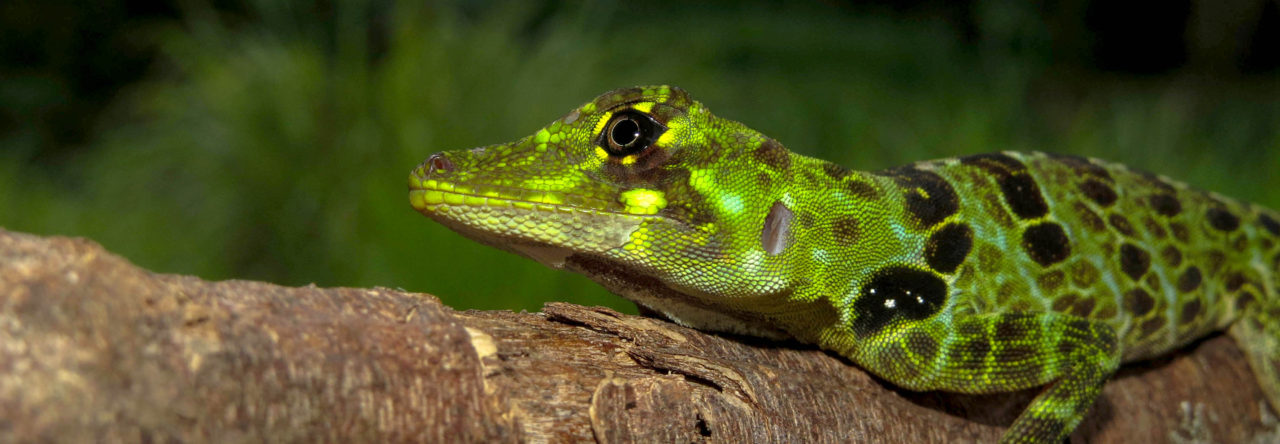Gunther Köhler has just published a paper in Zootaxa describing the many characters used in anole species descriptions. Here’s how he explains the endeavor:
“Anolis are important research organisms and many articles are published every year dealing with different aspects of the biology of these lizards. However, at this point we still lack detailed and standardized descriptions of all recognized species of Anolis. The species descriptions found in original descriptions, reviews of species groups, or faunal treatments are extremely heterogeneous in regard to content, usage of terms, semantic issues, and characters included. For example, some authors (e.g., Underwood & Williams 1959; Savage & Villa 1986; Köhler 2008) count the number of subdigital lamellae under Phalanges II–IV whereas others (e.g., Schwartz 1973; Williams 1995; Poe et al. 2012) report only the lamellae under Phalanges II and III. Even when the same characters are reported, often differences in definitions are evident with different authors scoring the same character differently, i.e., having different threshold levels for scoring qualitative characters (e.g., whether to consider a scale to be smooth, faintly, or weakly keeled, or not, slightly or distinctly enlarged relative to adjacent scales). Also, the way the data are generated can differ widely depending on the applied methodology. In 1995, Williams provided definitions for 37 morphological characters intended for usage in a computerized key for anoles. Williams’ (1995) approach aimed mostly to bring definitions and encodings of morphological characters usable in a computer program. Therefore, he was forced to simplify many of the included character states thereby masking the extent of variation actually observed in the genus Anolis. This article aims to provide definitions of external morphological characters that are useful in Anolis taxonomy with the goal of establishing a reference for future taxonomic work with these lizards. I am confident that a description containing the set of characters defined here will be reasonably complete for the majority of species. In species that show special morphological differentiations (such as the rostral appendage in A. proboscis), these special features need to be addressed of course. I have included many images illustrating the variation in the characters discussed, although I do not attempt to provide a comprehensive review of the variation in external morphology in anoles.”
A variety of morphometric characters from snout-vent length and head width to postcloacal scale width. Here’s one as an example:
Diameter of parietal scale. The longitudinal (LDP) and transverse (TDP) diameters of the parietal scale are measured. LDP and TDP both are measured at the greatest length and width, respectively. Slender projections of the parietal scale should be ignored in cases where these are beyond the normal concave or convex outline of the scale.
The heart of the paper is a description of a large number of scalation characters and their various alternative states. For example:
Condition of supraocular scales (CSO). These vary from smooth or rugose to weakly or strongly keeled; keeling can be uni- or multicarinate. Examples are given in Fig. 12.
Condition of circumorbital scales (COS). In many species of anoles, a row of small scales separates the enlarged supraocular scales from the scales of the supraorbital semicircles. Thus, this character refers basically to the scales situated medially to the enlarged supraocular scales; laterally to the enlarged supraocular scales usually numerous small scales are present without differentiated scales that can be identified as circumorbitals. Considerable intra- and interspecific variation can be observed in this character as exemplified in Anolis dunni (Fig. 13) with the circumorbital series varying from complete (one or more rows of scales) to incomplete or absent. Whenever one or more enlarged supraocular scales are in contact with scales of the supraorbital semicircles, the circumorbital series are incomplete or absent.
And one more set of examples:
Number of scales between supraorbital semicircles (IO). In most species of anoles a pair of semicircular series of enlarged scales is present in the frontal region between the supraocular discs. The minimum number of scales between the supraorbital semicircles is determined (i.e., usually at the narrowest point; Fig. 22).
Number of scales between supraorbital semicircles and interparietal plate (IP/IO). The minimum number of scales between the supraorbital semicircles and the interparietal plate is determined (Fig. 22). This character obviously is ignored in species that lack a differentiated interparietal plate (e.g., Fig. 22B).
Size of scales adjacent to interparietal plate (ScIP). The relative size of the scales surrounding the interparietal plate is noted. In some species the size of the scales anterior to the interparietal plate differs from those situated posteriorly to it. See examples in Fig. 22.
This looks to be a very useful contribution, particularly as the number of newly described anoles continues to rise.




















 A new movie on snake research, an Alex Pyron production, features not only great snake footage, but cameo appearances by anoles and Frank Burbrink explaining how he got out of prison and into herpetology (see disclaimer below), as well as wildfires in the Brazilian Cerrado, and plenty of other frogs, lizards, and rock and roll music.
A new movie on snake research, an Alex Pyron production, features not only great snake footage, but cameo appearances by anoles and Frank Burbrink explaining how he got out of prison and into herpetology (see disclaimer below), as well as wildfires in the Brazilian Cerrado, and plenty of other frogs, lizards, and rock and roll music.


